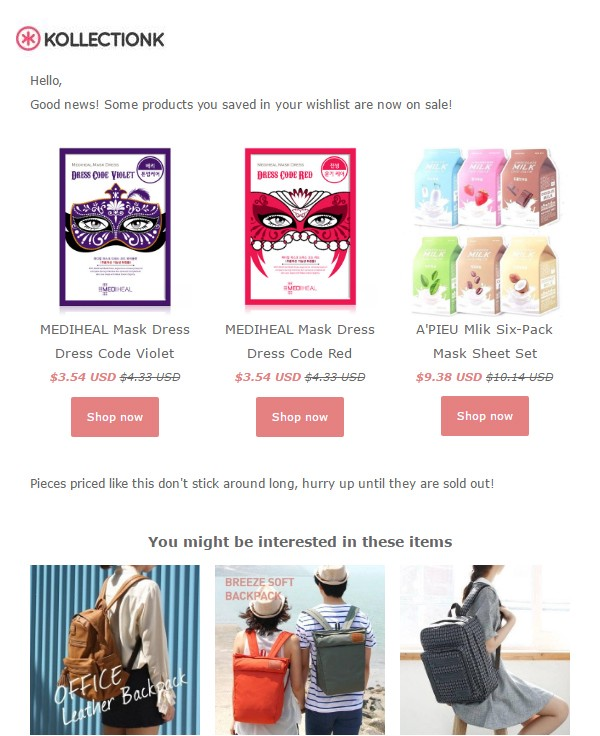You can quite easily take all of that ‘big data’ collected on your ecommerce website and use it to fuel your email marketing campaigns. By implementing a number of simple triggers, you can create an automated sales-converting machine. Yes, we’re still talking about email.
Insight: Ecommerce is a competitive industry. To get more people to buy, marketers need to understand that it’s all about sending the right communication at the right time.
Data: Marketers report that behaviour-triggered emails account for 30% of revenues in 2014, up from 17% in 2013 (DMA)
Key Action Point: We’ve come to a point where marketers need to go beyond “Hi, [FIRST NAME]!” to get people to buy. In this blog post, learn how to improve your customer experience through personalised emails based on customer behaviour.
Email is one of the cheapest digital channels ecommerce businesses can leverage. A tool that can result in an impressive ROI, not only can you reengage inactive customers with it, you can also use it to support and increase sales.
Whilst company-wide sales and promotions work, a more successful conversion strategy is in-email offers based on buyer behaviour, otherwise known as behaviour email marketing.
How Does Behavioural Email Marketing Work?
Behavioural email marketing is all about creating hyper-relevant, customer-centric emails that are sent to customers based on a previous action they’ve taken (or even actions they did not take).
This could be submitting a form, browsing products, buying products, abandoning products — basically any action taken on a website. You can even get more granular like determining what categories they are most interested in or what time of the day they like to browse, but for the sake of this blog article, we’ll stick with the low-hanging fruit.
HubSpot’s Principal Inbound Professor Isaac Moche says it best: “Behavioral email is all about adopting a user-focused approach to sending email. In other words, it is the actions of your site visitors that dictate what emails they receive, not a decision made by a marketer.”
Why Behavioural Email Marketing Works
It’s all about sending the right communication at the right time. Email marketing platforms allow us to do this through automated triggers. Behaviour-based email campaigns are activated when a customer interacts with your brand in a specific way.
The reason behaviour emails are successful is that it allows brands to give immediate value at key moments in a buyer’s journey.
Unlike traditional email campaigns where the marketer defines the message and blasts it to the entire database, this trigger-based messaging strategy works because marketers let customers decide what emails they want to receive, based on their actions.
No wonder 77% of ROI comes from segmented, targeted, and triggered email campaigns.
Statistics also show that trigger-based personalised email campaigns that have dynamic content outperform newsletters by 300%.
Continue reading if you want to find out how to outperform your current newsletter by 300%...
Getting Started: Behavioural Email Opportunities for Ecommerce Brands
Here are four must-haves for your ecommerce brand.
1. Welcome Emails
Welcome emails, otherwise known as onboarding emails, are triggered when someone completes a customer registration form or a blog subscription (usually incentivised).
It sounds basic, but first impressions really do count. A welcome email is your opportunity to cement your brand and its personality.
Seven out of 10 of your new subscribers expect to get a welcome email immediately after they subscribe to your list, and when you do send one, they are more likely to engage with your brand 33% more. With an average open rate of 50%, this type of email is 86% more effective than email newsletters.



Credits: Modcloth
When creating a welcome email, focus on introducing your brand’s customer value proposition, your brand purpose, what they can expect, your wishlist or rewards systems, and so on. This is also a great opportunity to prompt them to follow your brand on social media by showcasing your best content.
2. Abandoned Cart Series
Online shopping cart abandonment is a problem in Australia. In fact, shoppers in Australia (57%) abandon online carts more often compared to those in North America (47%) and Europe (41%), according to the SAP Consumer Propensity Study.
This can lead to losing more than half of potential sales. To remedy this, it’s important that we first understand why shoppers leave their items at checkout.
The Future of Australian Retail reported that 52% of customers say high-delivery costs are the number 1 reason they lose interest in buying. Other reasons include lengthy online payment processes, lack of relevant payment options, security concerns, and unexpected charges.
While persuading all cart abandoners to continue shopping is impossible, it’s worth addressing the hesitations they may have and giving them a little nudge. One great way to do this is by building an “abandoned cart” email series.
“Abandoned cart” email series is an email strategy to convert those customers who added a product to their cart but did not progress to confirmation or purchase. Depending on the basket size, you can incorporate offers like free shipping or 10% off the order to get the buyer over the line.

Credits: ASOS
You might ask, what’s the value of going after with cart-abandoners? Econsultancy’s insightful statistics will make you rethink about dealing with it: 48.1% of basket abandonment emails were opened and 33.3% of these clickers went on to purchase a product.
So reclaim your sales with triggered emails. Here’s an example of an automated series involving three or more triggered emails:
Email 1: Simple notification
- The first email should be sent four hours after someone has abandoned the cart
- Keep it short, sweet, and straight to the point
- Your calls to action might be ‘View cart’, ‘Complete order’, ‘Visit store’
- This email often works for the potential customer who genuinely forgot or was distracted
Email 2: Create urgency
- Trigger: 24 hours later and the customer has not taken any action after receiving the first email
- Messaging could be around ‘Don’t miss out’, ‘Hurry while stocks last’
- A clear call to action would be ‘Complete order’
Email 3: Discount offer
After 48 hours and still no purchase has been made, we can assume that the potential customer is no longer interested. One way to get them over the line is to offer a discount on their order.
But it has to feel natural, not desperate: “To brighten up your week, we’ll offer you 10% off your order!” You can also set up this trigger to only send to those whose abandoned cart has reached a certain amount to ensure you’re not going below your profit margin.
A powerful combination of an “abandoned cart email series” and retargeted product ads will work wonders.
3. Re-Engagement Campaign
This may be painful to hear, but according to Marketing Sherpa, you will lose around 22.5% of your email database each year through a mix of unsubscribers and dormant contacts.
Marketing is a contest for people’s attention. The online buyer has a myriad of options, and you’re definitely not the only brand tantalising their inbox. The weekly newsletters of sales and product drops won’t cut it, so implementing strategies to maintain engagement is a must.
When your customers’ behavioural data shows that they haven’t bought for you in six months, it’s time to trigger some love and appreciation.
These emails come in the form of ‘It’s been a while’ or ‘We miss you’. According to a study done by Klaviyo, these subjects lines have open rates of 35% and 30.29%, respectively.
Why so significant? Do they feel sorry for the brand? Likely not. Do they feel flattered? Maybe. Do they sense a sweet deal inside? Probably. Either way, they’re opening them.
To get the best results in your re-engagement campaign, your emails must contain some of the following elements:
- A fun and witty message leaving a nice taste of brand
- Beautiful design and imagery
- Your most popular products
- Products they’ve bought in the past
- Discounts, vouchers, or deals
The go-to re-engagement gift is a voucher. Winning back dormant shoppers might come with a cost, but this cost is much lower than the cost to acquire a new customer.
You can use the same voucher as one I talked about in the abandoned cart series. See an example below from Meshki, and notice how the large font ‘$20 GIFT VOUCHER’ captures your attention, whilst the condition is a mere afterthought.
Use this technique if you want to win over customers and move the product; otherwise, you can try your best to persuade them with kind words and fresh content.

Credit: Meshki
4. Replenishment
Remember the 1:4:7 rule of thumb:
It takes $1 to keep a customer, $4 to cross-sell them, and $7 to obtain a new customer.
In the world of ecommerce, value and retention are king. This is why replenishment emails are the easiest way to earn recurring revenue. In fact, research shows that this type of email has an average open rate of 50% to 60% and an average click rate of 40% to 50%. Implementing this would improve your repeat purchase rate.
Replenishment emails remind customers to re-order your product before they run out of it. You could provide a link that directs them to your landing page where they can complete the order.

Image source: Vero
You can activate your triggers based on wishlist, pages they’ve visited, or products they’ve bought in the past.
5. Wishlist
Including a wishlist or a saved items feature creates an opportunity for your ecommerce site to convert mere visitors into customers. We don’t expect every one of your visitors to be ready to buy right away; for some people, if they really like a product but have no intention to buy it right now, they’d add it in their wishlist.
As a retailer, it’s a great opportunity to ensure that they return to their wishlist page and actually make a purchase. After they add an item on their wishlist, you can trigger a series of emails containing valuable data from their wishlists. Leverage the content of their wishlist to highlight items low in stock, back in stock, on sale, and so on.

Source: Kollectionk
Wrapping It All Up: Let Your Customers Guide Your Email Marketing Strategy
To wrap it all up, we look at this conclusion from Isaac Moche, HubSpot’s Inbound Professor. He pointed out, “The strategy marketers rank most effective for improving email engagement is the one that we use the least.”
Behavioural email marketing is that powerful email marketing strategy that many marketers miss to leverage. By setting up your behavioural marketing strategy, you are setting yourself up for a better relationship with your audience and greater sales.
















